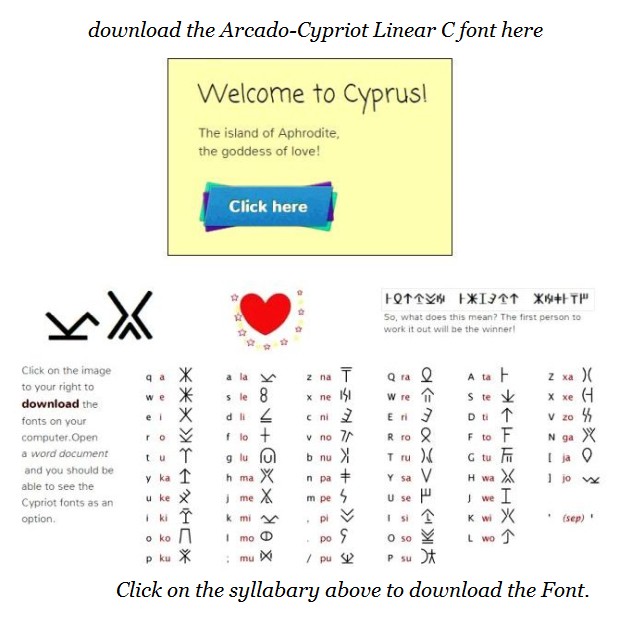The Arcado-Cypriot Linear C keyboard template & the significantly revised timeline for (proto-) historic ancient Greek society:This image of the Arcado-Cypriot Linear C keyboard template has been downsized to 620 pixels to fit the restrictive exigencies of Word Press image size. You may request the full-sized 1200 pixel Linear C keyboard template by contacting me at: vallance22@zoho.com The Arcado-Cypriot Linear C keyboard template reveals several fascinating characteristics of this extremely important and highly tenacious syllabary. These are: 1. The Arcadians and Cypriots thoroughly redesigned Linear C, almost completely abandoning the Minoan Linear A and Mycenaean Linear B syllabograms, but only in superficial appearance. 2. The only Linear C syllabograms which bear resemblance with their Mycenaean Linear B forbears are: NA SE PA & PO. 3. But almost all of the rest of the syllabograms in Linear C bear the same phonetic values as their Linear B forbears. 4. The DA series of syllabograms in Minoan Linear A and Mycenaean Linear B has completely disappeared from Arcado-Cypriot Linear C. 5. The RA RE RI RO (RU) series of syllabograms in Minoan Linear A and Mycenaean Linear B has split into 2 discreet, separate series: LA LE LI LO LU & RA RE RI RO RU. But what was the reason for this deliberate split? Here is my hypothesis: it would appear that the Minoans and Mycenaeans were unable to distinguish between the liquids L and R, pronouncing L something along the lines the Japanese did. 6. The syllabograms XA and XE, and the syllabogram GA are non-existent in Minoan Linear A & Mycenaean Linear B. 7. Arcado-Cypriot Linear C abandoned ideograms completely. This makes for a much more - 8. streamlined syllabary. 9. The Arcado-Cypriot Linear C syllabary was diachronically extremely tenacious, lasting 7 centuries (ca. 1100 BCE – 400 BCE) co-existing in parallel with the Arcado-Cypriot alphabet. 10. philologists and linguists expert in ancient Greek are accustomed to drawing the timeline for the first appearance of written Greek from 800 BCE onward (ca. the time of Homer’s Ilad to Attic Greek, ca. 400 BCE).

But I am in fundamental disagreement with this hypothesis. Since Arcado-Cypriot Linear C came to the fore ca. 1100 BCE, a mere 100 years or approximately one century after the fall of Mycenae and the demise of the Linear B syllabary, it is surely open to doubt whether or not the so-called Greek “Dark Ages” actually lasted at least 400 years (ca. 1200 – 800 BCE). So we have to wonder whether or not that small gap of a mere century or so between the demise of the Linear B syllabary (ca. 1200 BCE) and the sudden appearance of Arcado-Cypriot Linear C (ca. 1100 BCE) makes much of a difference at all in the actual timeline for written ancient Greek, which to my mind runs from 1600 BCE, with the advent of Mycenaean Linear B, all the way through to 400 BCE, i.e. for 12 centuries – 1 century (because of the 1 century gap between Linear B and Linear C), i.e. for 11 centuries! This makes for a huge difference between the previously held timeline of a mere 4 centuries from 800 – 400 BCE. It sets back the timeline for Greek civilization 500 years, receding back from 1100 BCE to 1600 BCE. I also strongly object to the commonly held notion that Mycenaean and Mycenaean Minoan Greece was a prehistoric civilization. Since writing did exist in the form of the Linear B syllabary, albeit only in scribal format, I believe we can safely conclude that the Mycenaean civilization was proto-historic. And there is more: if we also take Minoan Linear A into account (which we definitely should), then the proto-historic period, if we are to include the pre-Greek substrate of Minoan society, recedes several centuries more into the distant past, to at least 2,900 BCE! Just because we cannot read the Minoan language does not mean it not also proto-historic phenomenon. That Arcado-Cypriot Linear C lasted for such a very long time attests to the fact that syllabaries such as Mycenaean Linear B & Arcado-Cypriot Linear C itself were much more suitable to inscribing or writing ancient Greek than most philologists or diachronic historical linguists would care to admit. I shall have plenty to say about this in the article I shall soon be posting on my academia.edu account: Templates for the layouts of the Minoan Linear A, Mycenaean Linear B & Arcado-Cypriot Linear C fonts. You can download the Linear C font here:

3 thoughts on “The Arcado-Cypriot Linear C keyboard template & the significantly revised timeline for (proto-) historic ancient Greek society”
Comments are closed.

Fascinating ! Thanks Richard.
LikeLike
Yes, it is! I am writing my next article for Archaeology and Science on Arcado-Cypriot Linear C.
LikeLike